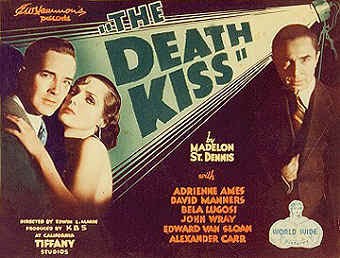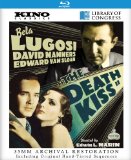| Reviews & Columns |
|
Reviews DVD TV on DVD Blu-ray 4K UHD International DVDs In Theaters Reviews by Studio Video Games Features Collector Series DVDs Easter Egg Database Interviews DVD Talk Radio Feature Articles Columns Anime Talk DVD Savant Horror DVDs The M.O.D. Squad Art House HD Talk Silent DVD
|
DVD Talk Forum |
|
|
| Resources |
|
DVD Price Search Customer Service #'s RCE Info Links |
|
Columns
|
|
|
Death Kiss, The
The Death Kiss (1933*) didn't sound very promising, suggesting the usual cheap Poverty Row murder mystery, of interest solely, I had imagined, because it features three of the stars of Dracula (1931): Béla Lugosi, David Manners, and Edward Van Sloan.
But, lo and behold, The Death Kiss proves a winner all the way, a true delight. Though not quite great, it's nonetheless extremely entertaining throughout, smart, and creative in every department. Indeed, it's the best low-budget movie this critic has seen in ages.
Better still, Kino's new Blu-ray is mastered in high-def from archival 35mm elements preserved by the Library of Congress. It may not be the revelation that Universal's Dracula was on Blu-ray a few years back, but it's pretty close. Except for two reels sourced from inferior elements, The Death Kiss looks amazing considering its age and obscurity. In short, the movie plays better than and looks superior to even most big studio productions of its time.
On the steps outside the Café Henri, a femme fatale walks up and kisses a total stranger. "Thanks, pal," she says, matter-of-factly, "I just couldn't pass you up!" The kiss is a signal to gangsters in a nearby sedan who then gun down the man in a hail of bullets.
"Cut!" shouts the film's director, Tom Avery (Edward Van Sloan), as the murder turns out to have been a scene staged for movie cameras. (This twist was old hat by the ‘50s, but still relatively novel then, and comes as a genuine surprise.) Avery calls for another take, but the man, actor Myles Brent, has been shot for real. Tonart Studios scrambles to address the torrent of publicity the star's murder is certain to arouse, while Det. Lt. Sheehan (John Wray) and other officers arrive at the scene.
Studio head Leon A. Grossmith (Alexander Carr) struggles to decide whether to shelve the film or replace Brent with a double. Studio manager Joseph Steiner (Lugosi) handles the press with kid gloves, and screenwriter Franklyn Drew (David Manners), in love with the actress in the scene, Marcia Lane (Adrienne Ames), annoys the heck out of Sheehan by conducting his own parallel if amateur investigation of the crime.
Early evidence points to Chalmers (Alan Roscoe), an alcoholic ex-gaffer hired by a sympathetic Marcia for a bit part in the film. When Chalmers later turns up dead in an apparent suicide, the case seems solved, but Drew isn't convinced, and with the help of dim-witted studio guard "Gully" Gulliver (Vince Barnett), Drew becomes determined to solve the case on his own.
The Death Kiss's script, by Gordon Kahn and Barry Barringer, from a book by Madelon St. Denis with additional dialogue by Joe Traub, takes a familiar premise of mystery stories (murder at a movie studio, sometimes also during the performance of a play) and infuses it with inventiveness and surprisingly witty and authentic dialogue.
For starters, movies set in movie studios almost always are pitifully inaccurate about the manner in which motion pictures are made, and what everyday life inside studio walls is like. (Ironic, ain't it?) Several later, bigger films managed to capture the milieu of studio life somewhat better, if cynically so (The Bad and the Beautiful, A Star Is Born, the 1954 version especially). But here, way back in 1932, The Death Kiss rings true as few Hollywood movies about Hollywood ever have.
Everyone's job and position at the company is clearly and carefully defined. Grossmith talks like Samuel Goldwyn ("Oy! What a calamity!" he cries, repeatedly), and may even have been based on that colorful producer. Unlike other films that usually depict directors as hotheaded despots in pith helmets, jodhpurs and holding megaphones or riding crops, Van Sloan's character, in a simple suit, is quietly but firmly in charge, and in a later scene he's concerned about how the proposed use of a double to complete the film might damage his reputation. Chalmers is correctly identified as an ex-gaffer: "What's that in plain English?" asks Lt. Sheehan.
The studio-set script also obviously saved the producers of The Death Kiss a lot of money. A slightly redressed Tiffany Studios (located near where Hollywood and Sunset Boulevards intersect; it had been D.W. Griffith's studio in the silent days) was used. Authentic early talkie cameras (appropriately blimped, unlike similar films), lights, sound equipment, etc. are all visible, and many scenes set in other departments (property, makeup, etc.) often use those real buildings, too.
The mystery aspects are unexpectedly solid. The clues Drew finds and the suppositions he derives from them are all reasonable, and the film uses its red herrings well, avoiding obvious misdirection.
The Death Kiss is well made in other respects, too. Compared to the sometimes stilted, theatrical acting in Dracula, The Death Kiss is far more naturalistic, breezy and relaxed, though still moderately stylized. Director Edwin L. Marin, best known for MGM's 1938 version of A Christmas Carol and for nine films, mostly Westerns, he made with Randolph Scott (a John Wayne Western Marin directed, Tall in the Saddle, is also good), likewise uses the camera well. Low-budget movies, with their super-short shooting schedules, tended toward wide, static medium shots, but Marin mixes a wide variety long shots, tight close-ups and everything in-between, including moving the camera about a lot.
An added bonus is the addition of hand-tinted highlights in two key scenes by artist Gustav Brock (he also tinted Erich von Stroheim's Foolish Wives). Similar effects turn up in loads of silent movies but, as far as I know, rarely in sound-era features. (Akira Kurosawa's High and Low, from 1963, does something similar.) The effects are fairly extensive in these two short scenes, and are startlingly effective.
Where David Manners was stiff and unconvincing in Dracula, he's relaxed, likeable, and amusing in The Death Kiss. Van Sloan is also better, and Vince Barnett is pretty funny in the comedy relief role, dumb but not offensively stupid.
As for Lugosi, he seems a bit shoehorned as the studio manager who's job it is to deal with the press. It's a stretch imagining thick Hungarian-accented Lugosi talking up Tonart's latest picture with reporters over the phone: "Our-r-r new pee-shure is destined to be a gu-reat su-CESS!" "What's that you say?" It was neither the first nor the last of Lugosi's many red-herring roles, but the character is integrated into the story well, and Lugosi gets to act like a normal human being throughout.
Video & Audio
Considering The Death Kiss is an 82-year-old movie from a production company and distributor out of business for nearly 81 years, to say nothing of its public domain status, the film looks astoundingly good. Reels 2 and 5 (I think) are in worse shape than the rest of the movie, but acceptable, with only one scene marred by a series of awkward splices that render a bit of dialogue nearly incomprehensible. Mostly, however, The Death Kiss looks great; not brand-new, perhaps, but superior to most early talkies on DVD and Blu-ray. All the tinting effects are intact and make a big impact when they appear. The audio is also quite good most of the time, though around the 41:45 mark drops noticeably in fidelity for a few minutes.
Apart from a trailer for the Kino-distributed White Zombie, the only Extra Feature is a terrific one, a fact-filled, observant audio commentary track by historian Richard Harlan Smith that puts its cast, crew, and production generally into historical and cultural perspective.
Parting Thoughts
One of the best Blu-ray surprises of 2014, The Death Kiss won't appeal to everyone, but for fans of such pictures this is a true delight. Highly Recommended.
* The movie was apparently previewed in early December 1932 with a national release starting that Christmas, but the release was pushed into 1933 to facilitate the hand-tinting described elsewhere in this review. Most sources, however, inaccurately list this as a 1932 release.
Stuart Galbraith IV is the Kyoto-based film historian and publisher-editor of World Cinema Paradise. His credits include film history books, DVD and Blu-ray audio commentaries and special features.
|
| Popular Reviews |
| Sponsored Links |
|
|
| Sponsored Links |
|
|
| Release List | Reviews | Shop | Newsletter | Forum | DVD Giveaways | Blu-Ray | Advertise |
|
Copyright 2024 DVDTalk.com All Rights Reserved. Legal Info, Privacy Policy, Terms of Use,
Manage Preferences,
Your Privacy Choices | |||||||













